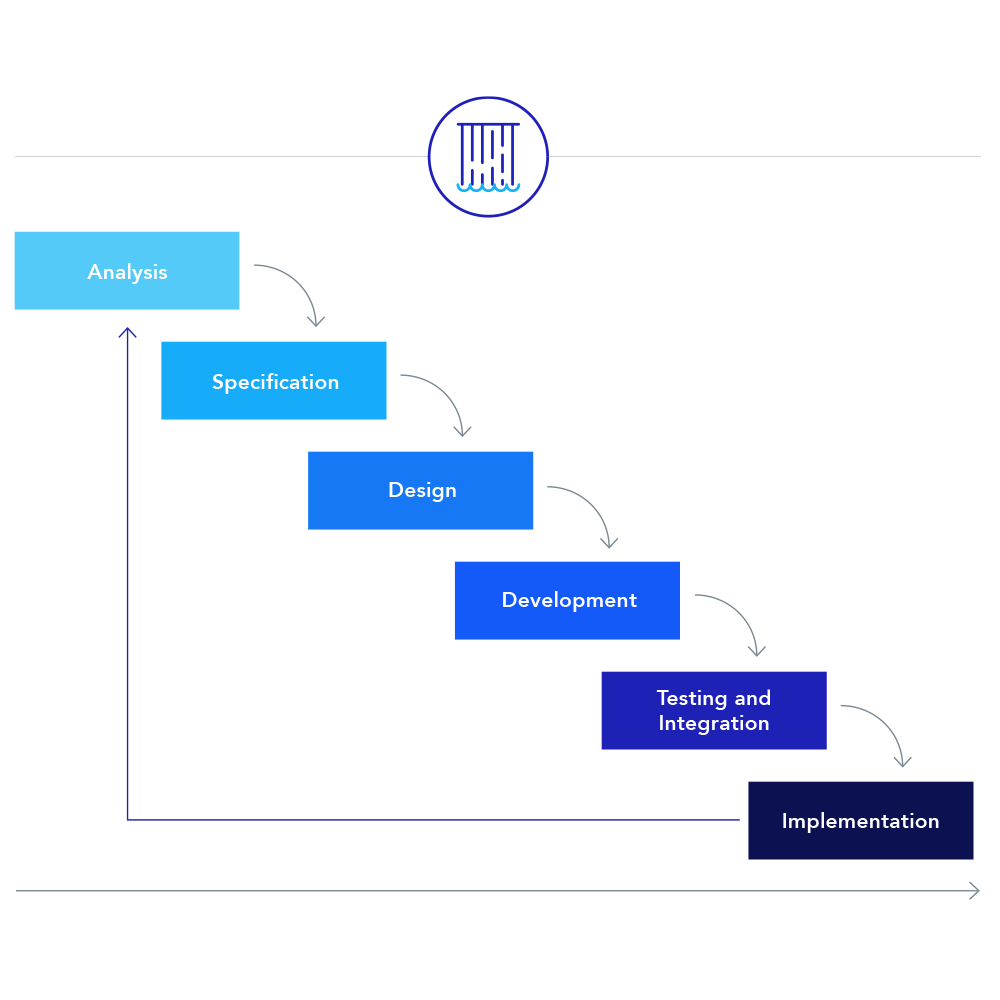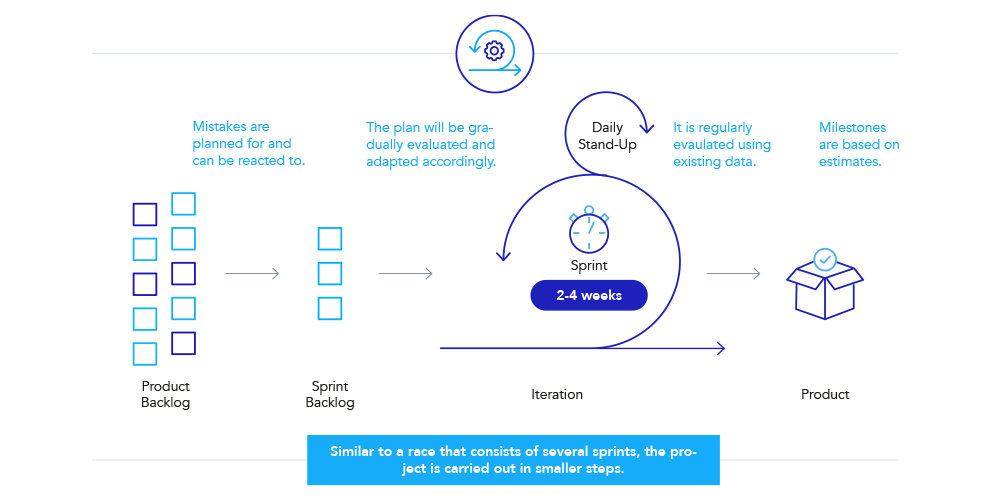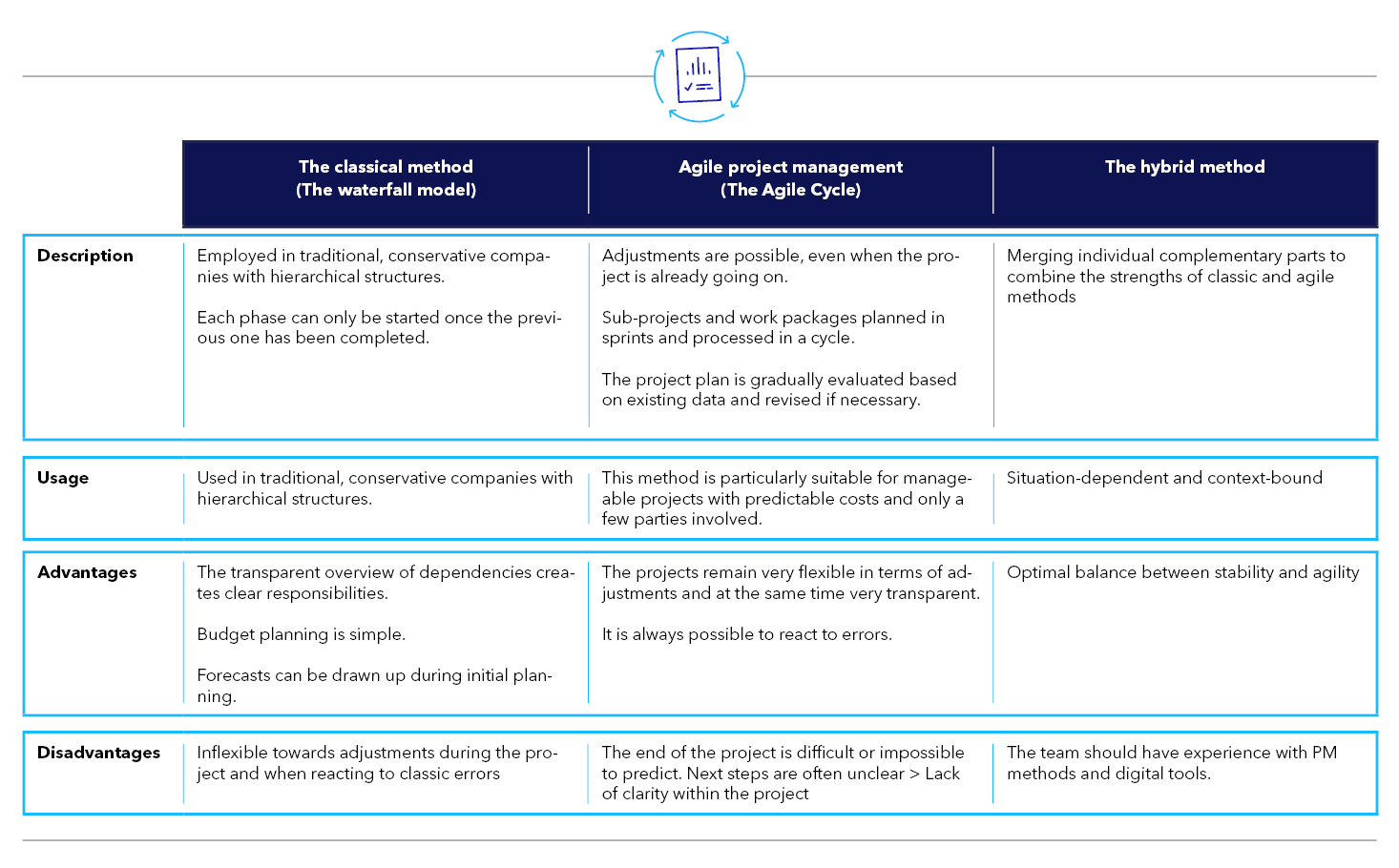Excellent project management is crucial for product development and other services companies provide. The key performance indicators in project management are effectiveness and efficiency.
Due to global changes, the growing number of stakeholders involved and regulatory requirements, project management and implementation in companies is becoming increasingly complex. The volatile demands of customers are increasing the project risk. To overcome these problems, professional procedures and methods have been developed, which can be divided into classic and agile project management approaches. Although both approaches have their strengths, they cannot always be used successfully due to the demands placed on them. This is why hybrid forms have been created from the two methods, which are significantly more contemporary and effective. The advantages and disadvantages of the conventional management methods and the benefits of introducing the hybrid approach as a combination are described below.
The classic project management method: the waterfall model
Even today, many project management methods that are used in projects are still rather classic. In traditional project management, a waterfall system is common, which is often used in classic, conservative companies with hierarchical structures and requirements. This involves dividing large projects in the company into several phases that build on each other. The decisive factor here is that each phase can only be started after the previous one has been completed. Thanks to the transparent overview of dependencies, clear responsibilities can be assigned, and budget planning is simple. The individual project phases are then scheduled in relation to each other so that a forecast for the end of the project can already be defined when the project is initially planned. This can also be presented to stakeholders if required. However, especially in the current uncertain times, it is very difficult to plan phases that are still far in the future with precision. After all, if a project phase cannot be completed according to plan, all subsequent phases are immediately postponed. This means you are inflexible when it comes to making adjustments to the project and reacting to typical errors.
Advantages of the method:
The transparent overview of dependencies creates clear responsibilities. Budget planning is simple. Forecasts can be made during initial planning.
Disadvantages of the method:
Inflexible to adjustments in the project and in reaction to classic errors.

To sum up, spontaneity is very limited in this model because, like a waterfall, there is only a linear approach; there is a chronological (if/then) sequence.
Agile project management: The Agile Cycle
The agile project management method is designed to remain agile and ensure ongoing flexibility with regard to adjustments. The predefined sub-projects and work packages are planned in sprints and processed in a cycle. Depending on the design, these sprints usually take 2-4 weeks. This method suits manageable projects with predictable costs and few parties involved. The idea behind the agile method is to gradually evaluate the project plan based on the available data and revise it if necessary. The feasibility of implementation can be reassessed after each iteration and the next steps can be adapted to the current situation in a completely agile manner. This means that the projects remain very flexible in terms of adjustments to the plan and at the same time very transparent. Mistakes are not uncommon with this agile approach, but they are also planned for. The focus is placed on achieving the first agile results quickly rather than investing too much time in a meticulous planning phase. Thanks to the flexible approach, it is always possible to react to errors. Nevertheless, the end of the project is difficult or impossible to predict and the next steps are often unclear, which can sometimes cause confusion within the project. Some of the best-known agile methods in project management are Scrum and Kanban.
Advantages of the method:
The projects remain very flexible in terms of adjustments and at the same time very transparent. It is always possible to react to errors.
Disadvantages of the method:
The end of the project is difficult or impossible to predict. Next steps are often unclear → Lack of clarity within the project

The hybrid project management method: the combination of classic and agile
The hybrid method is the merging of individual complementary parts in order to combine the strengths of classic and agile methods. The different approaches can be individually combined and adapted to the project. According to the waterfall method, the rough project milestones can be planned in advance, especially where there are clear responsibilities in the operational business, such as in product planning. However, in the subsequent product development phase, many specialist areas and organizational levels overlap. In this step, the resulting work packages should be processed agilely. On the other hand, the product launch is much easier to plan, which means that waterfall planning can be used here.
The following factors play a role in hybrid project management:
-The type of organization
-Size of the project
-Stakeholders involved in the project
- Experience of the team leader in managing projects
- Project management and methods know-how of the team members
If you look at the construction of a prefabricated house, the waterfall method is much more suitable than the agile method, as the project is a stable process with a transparent allocation of roles. However, the agile method is more suitable for developing software, as the focus here is on adaptability and continuous improvement.
Would you like to learn more about hybrid project management, get to know hybrid methods in more detail and gain insights into proven best practice approaches? Then download our free resource!
Advantages of the method:
Optimal balance between stability and agility
Disadvantages of the method:
The team should have experience with PM methods and digital tools.
Hybrid project management - reasons why the combination is a useful method
Hybrid project management therefore attempts to find the optimal balance between stability and agility and allows the integration of different project management methods in order to increase effectiveness. However, hybrid project management also requires appropriate competencies and skills from project managers and the team. In addition to in-depth knowledge of traditional project management and agile methods such as Scrum or Kanban, they must be able to select and combine the right project management approaches and adapt them to the specific requirements of the project. Some requirements should therefore be fulfilled and established in the team, including a high degree of flexibility, adaptability and continuous learning.
A further important aspect of hybrid project management is the use of technology and digital tools that are specifically tailored to project management. These support communication, collaboration and documentation in distributed and virtual teams that are all working on the same project. By using project management software, collaboration tools and real-time data analysis, projects can be managed and monitored more efficiently.

Conclusion:
This article emphasizes the importance of an effective project management method for companies and explains the challenges of classic and agile project management. The benefits of the hybrid project management method, which is a combination of both agile and traditional approaches to optimize stability and agility in projects. The choice and adaptation of methods to project requirements and the use of digital tools and technology are crucial.
Do you work with projects and different methods, such as hybrid project management, on a daily basis and are responsible for managing a whole project landscape? Then our software, which is used for strategy and transformation or project portfolio management projects, could interest you!

